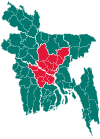Bandar Upazila
Bandar
বন্দর | |
|---|---|
 Tomb of Haji Baba Saleh | |
 | |
| Coordinates: 23°37′N 90°31.5′E / 23.617°N 90.5250°E | |
| Country | |
| Division | Dhaka |
| District | Narayanganj |
| Thana | 1964 |
| Upazila | 1993 |
| Government | |
| • MP (Narayanganj-5) | Salim Osman (Jatiya Party) |
| • Vice Chairman | Saiful Bhuiyan |
| Area | |
• Total | 54.39 km2 (21.00 sq mi) |
| Population (2011) | |
• Total | 312,841 |
| • Density | 5,800/km2 (15,000/sq mi) |
| Time zone | UTC+6 (BST) |
| Website | bandar |
Bandar (Template:Lang-bn) is an upazila (sub-district) of the Narayanganj District in central Bangladesh, part of the Dhaka Division. Bandar is a part of Greater Dhaka; the conurbation surrounding the Bangladeshi capital city of Dhaka.
Geography
Bandar is located at 23°35′35″N 090°31′13″E / 23.59306°N 90.52028°E. It has a total area of 54.39 km2. It is separated from Narayanganj Sadar Upazila and Munshiganj Sadar Upazila by the Shitalakshya River to its west and south. Bandar is bounded by Sonargaon Upazila to its north and east.[1]
History


The history of Bandar spans several centuries, and it became a principal port (bandar) not far from the medieval capitals of Sonargaon and Jahangirnagar. In 1481 AD, the Bandar Shahi Mosque was constructed which became a focal point for Islam in Bandar. A Muslim preacher and Bengal Sultanate officer by the name of Haji Baba Saleh migrated to a village in Bandar where he invited the locals to Islam. The village then came to be known as Salehnagar, or the city of Saleh. A mosque and mazar (mausoleum) was later built and named after him in 1504 AD.
After the fall of the Bengal Sultanate in the late sixteenth century, independent chieftains formed a confederacy known as the Baro-Bhuiyans to defend Bengal from Mughal integration. Numerous battles were fought in Bandar between the Mughal forces and Baro-Bhuiyans such as Musa Khan, Dawud Khan, Abdullah Khan and others. Musa's grandson, Dewan Munawwar Khan, later moved his residence to what came to be known as Dewanbagh (or Munawwar Khan Bagh) in Bandar, where he also built the Qadam Rasul monument and was buried east of the historic Dewanbagh Mosque.[2] Historians suggest that the Sonakanda Fort in Bandar was built by Mughal governor Mir Jumla II to protect against pirates.[3]
Bandar was established as a thana in 1964. During the Bangladesh Liberation War of 1971, a mass killing was conducted in Sirajdoullah Club playground leading to the death of 54 people on 4th April. On 22 November, a brawl took place between the Pakistan Army and the Bengali freedom fighters at the banks of the Shitalakshya in Dhamgar. Another battle took place 5 days later in which a Pakistan Army gunboat was destroyed and numerous Pakistan Army soldiers killed. Defeated again on 12 December, the Pakistan Army fled to the western side of the Shitalakshya. A direct encounter took place in Bandar Railway Station where many soldiers were killed or wounded and were forced to surrender. Bandar Thana became liberated on 15 December. In 1993, Bandar Thana's status was upgraded to upazila.[1]
Demographics
| Year | Pop. (000) | ±% |
|---|---|---|
| 1981 | 198 | — |
| 1991 | 213 | +7.6% |
| 2001 | 250 | +17.4% |
| 2011 | 313 | +25.2% |
| 2022 | 204 | −34.8% |
| Source: Bangladesh Bureau of Statistics[4] | ||
According to the 2011 Bangladesh census, Bandar Upazila had 73,173 households and a population of 312,841. 64,753 (20.69%) were under 10 years of age. Bandar had a literacy rate (age 7 and over) of 58.9%, compared to the national average of 51.8%, and a sex ratio of 974 females per 1000 males. 166,291 (53.16%) lived in urban areas.[4][5]
| Name |
|---|
| Bandar Islamia Senior Madrasa |
| Madanpur Riazul Uloom Senior Madrasa |
Administration
Bandar Upazila is divided into five union parishads: Bandar, Dhamgar, Kalagachhia, Madanpur, and Musapur. The union parishads are subdivided into 89 mauzas and 158 villages.[4][6]
Economy and tourism
Bandar's ancient history has made it a popular place of tourism. Home to 252 mosques, noted ones include the Bandar Shahi Mosque, the mosque and mausoleum of Haji Baba Saleh and the Farazikanda Mosque. Other notable sites include the Qadam Rasul in Nabiganj and the Sonakanda Fort, both dating back several hundred years.
See also
References
- ^ a b Bhuiyan, Md. Iftekhar Uddin (2012). "Bandar Upazila". In Sirajul Islam; Miah, Sajahan; Khanam, Mahfuza; Ahmed, Sabbir (eds.). Banglapedia: the National Encyclopedia of Bangladesh (Online ed.). Dhaka, Bangladesh: Banglapedia Trust, Asiatic Society of Bangladesh. ISBN 984-32-0576-6. OCLC 52727562. OL 30677644M. Retrieved 24 November 2024.
- ^ Khan, Muazzam Hussain (2012). "Dewan Munawar Khan". In Sirajul Islam; Miah, Sajahan; Khanam, Mahfuza; Ahmed, Sabbir (eds.). Banglapedia: the National Encyclopedia of Bangladesh (Online ed.). Dhaka, Bangladesh: Banglapedia Trust, Asiatic Society of Bangladesh. ISBN 984-32-0576-6. OCLC 52727562. OL 30677644M. Retrieved 24 November 2024.
- ^ সাংস্কৃতিক ঐতিহ্য. Daily Jugantor (in Bengali). 26 January 2015. Archived from the original on 29 January 2015. Retrieved 30 January 2015.
{{cite news}}: CS1 maint: unfit URL (link) - ^ a b c d "Bangladesh Population and Housing Census 2011 Zila Report – Narayanganj" (PDF). bbs.gov.bd. Bangladesh Bureau of Statistics.
- ^ "Community Tables: Narayanganj district" (PDF). bbs.gov.bd. Bangladesh Bureau of Statistics. 2011.
- ^ "History & Facts". Naryanganj City Corporation. Archived from the original on 13 December 2012. Retrieved 20 November 2020.

